- Home
- About Us
- Programs
- Being Here
- FAQs
- Resources
- News
- Links
- Support Us
Dec

We’ve been keeping records of the demographics of our residential students since 2009, and we’ve worked out some pretty geeky statistics from this data that we have been enjoying very much.
In the 6 year period 2009 – 2014:
- We had almost 8,000 residential students, from 88 countries
- Their age range was between 16 and 81
- We also had more than 40,00 attendances on our Non-Residential courses and Drop-in sessions
- Making a total of 48,507 participants in 6 years!
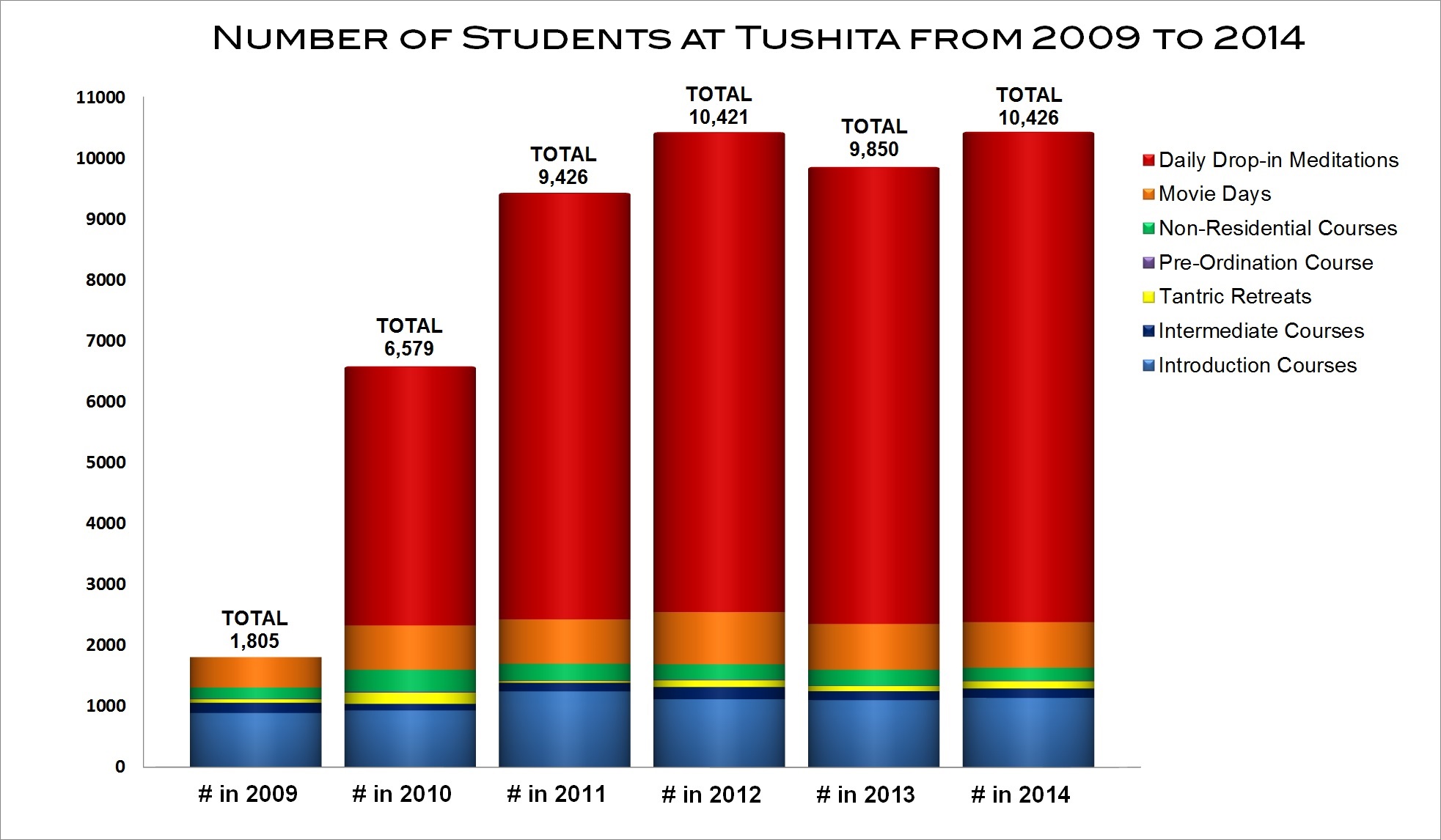
You can see that since we started keeping records in 2009, Tushita has grown a lot, particularly since we began to offer our daily guided meditation sessions in April 2010 (therefore the jump in 2011 partly reflects the fact that these sessions ran throughout the full 2011 season, 2 months more than in 2010). As you can see from the chart above, in the past 5 years, our drop-in sessions have amassed almost 40,000 “cushion units”!
That’s to say that the same people often attend these sessions frequently, so it wouldn’t be accurate to say that this many individuals had attended, but no matter how you interpret the figures, our drop-in sessions are definitely well attended!
Logistically though, it’s the rise in student numbers on our residential courses that makes the biggest impact on us; participation on our Introduction to Buddhism courses saw a 40% increase in the first 2 years, and has leveled off since then – at our maximum possible capacity. Our numbers haven’t risen significantly since 2012, because we simply can’t fit any more students or courses in! The only factor we really notice affecting our records is how many non-residential courses we have the time and resources to offer.
Our general experience is that whatever we are able to offer, people come!
But who are these people who come on Tushita courses?
Where are Tushita’s Students From?
Between 2009 – 2014, we had students on our residential courses from 88 different countries!
Below left you’ll see “Table A”, a list of the top ten nationalities over that 6-year period, and a chart to the right showing these top ten nationalities (and the 78 others!) by percentage. Further down the page you’ll find a tab that says “Click here”, where you can see the full list of 88 – take a look and see if your country is represented. If not: come, we need you!
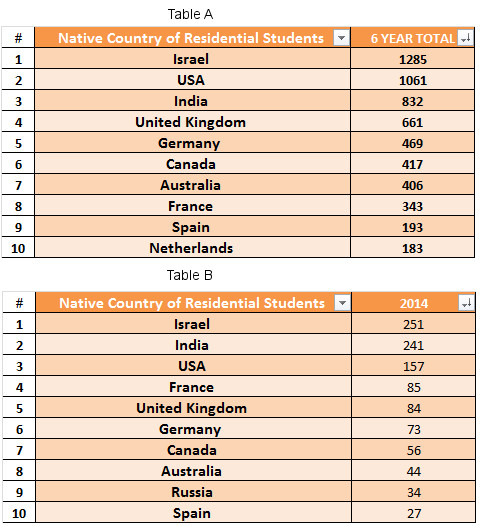
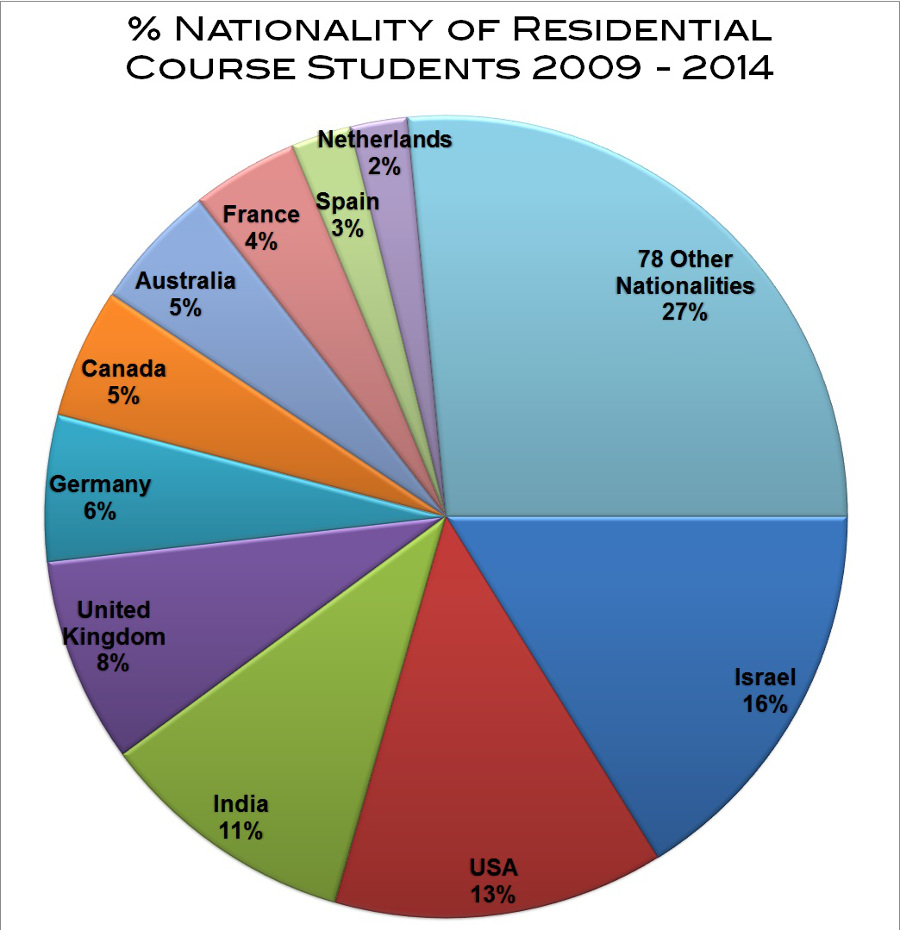
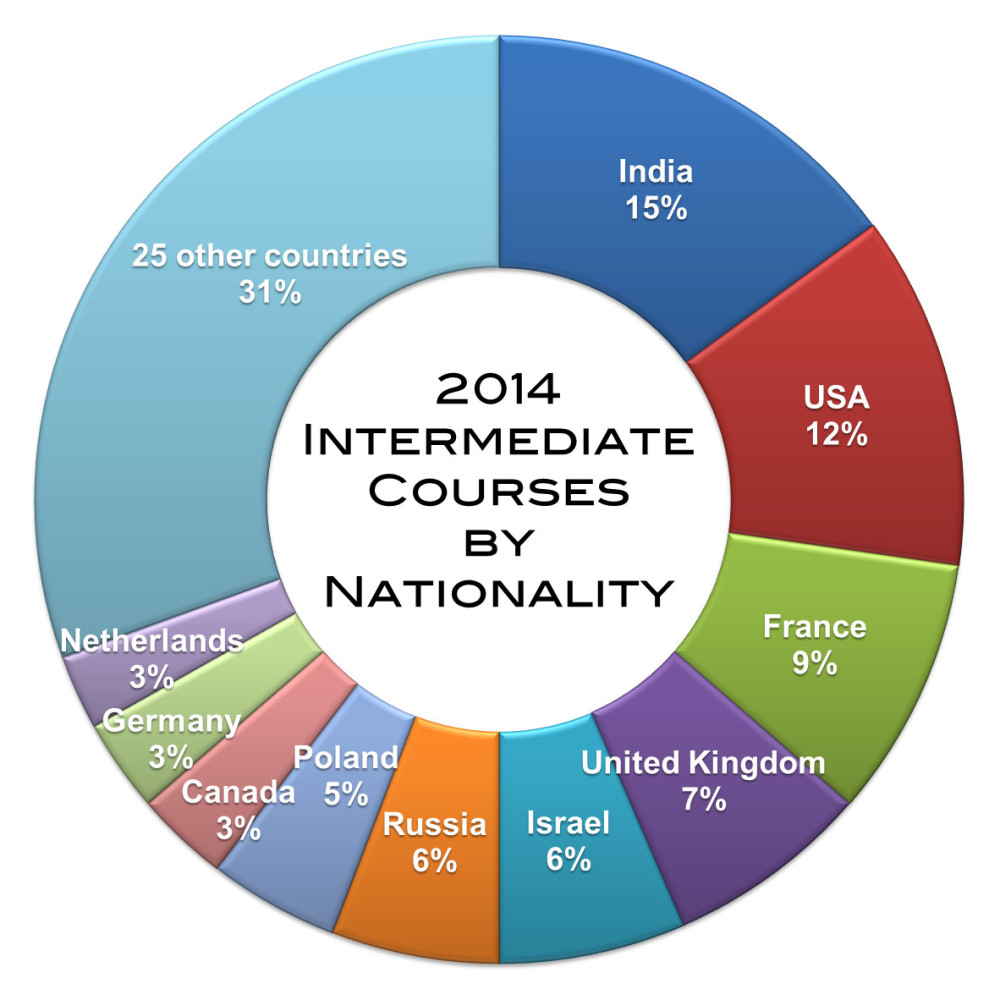
We have noticed some big shifts in national participation however, and on Table B above left you can see the top ten countries in 2014, with India now in very close second to Israel.
People are often surprised that we have so many Israeli students, but it is very common for young Israelis to travel to India after they have finished their National Service in the Army. These young Israeli citizens are often in a period of transition, seeking insight from alternative sources of wisdom, while not actually intending to adopt any fundamental changes in their own religious practices, belief or non-belief.
Therefore, Israelis have so far always been our biggest national group on Introduction to Buddhism courses, but very few continue onto Intermediate courses or retreats.
These courses see a much more even spread in Nationality (and age), and as you’ll see in the chart to the right, India is now our biggest nationality in non-Introductory courses. And catching up fast on Introduction courses too!
Here’s how that change has been happening – with India rising from the 6th most populous nationality in 2009, to the 2nd in 2014. The number of Indian citizens is rising so fast that it is easy to imagine that they will be our biggest nationality in 2015 and beyond. We rejoice – returning Buddha Dharma to the Motherland!
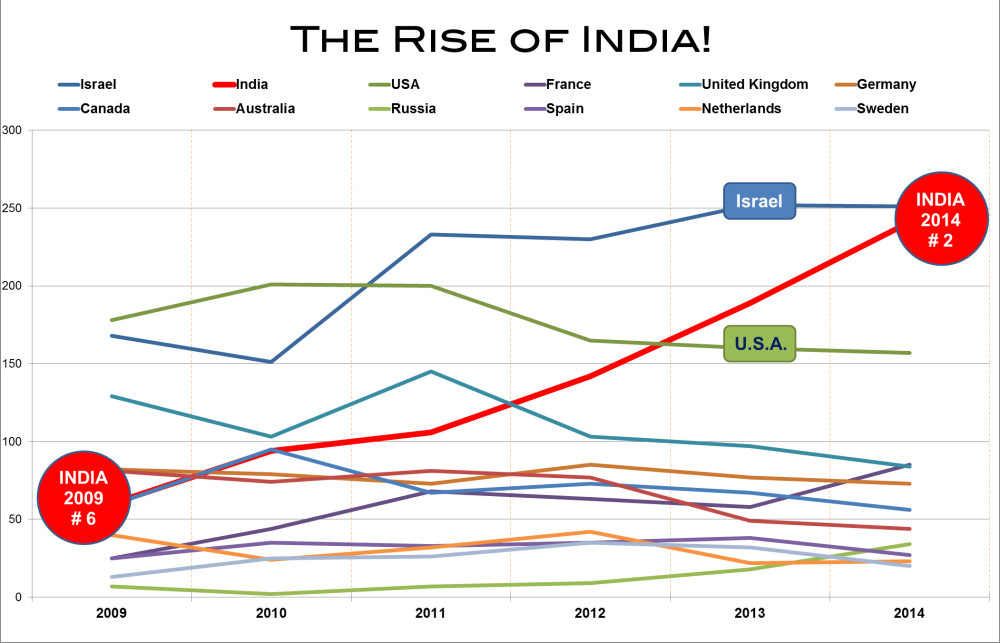
And click here to see a full list of all 88 countries!
| # | Native Country of Residential Students | 6 YEAR TOTAL |
| 1 | Israel | 1285 |
| 2 | USA | 1061 |
| 3 | India | 832 |
| 4 | United Kingdom | 661 |
| 5 | Germany | 469 |
| 6 | Canada | 417 |
| 7 | Australia | 406 |
| 8 | France | 343 |
| 9 | Spain | 193 |
| 10 | Netherlands | 183 |
| 11 | Sweden | 151 |
| 12 | Austria | 114 |
| 13 | Switzerland | 113 |
| 14 | Brazil | 109 |
| 15 | Mexico | 105 |
| 16 | Ireland | 103 |
| 17 | Italy | 96 |
| 18 | Argentina | 79 |
| 19 | Russia | 78 |
| 20 | New Zealand | 75 |
| 21 | Denmark | 72 |
| 22 | Belgium | 71 |
| 23 | South Korea | 66 |
| 24 | Finland | 64 |
| 25 | Poland | 62 |
| 26 | Japan | 51 |
| 27 | Portugal | 49 |
| 28 | South Africa | 46 |
| 29 | Chile | 46 |
| 30 | Colombia | 44 |
| 31 | Taiwan | 34 |
| 32 | Czech Republic | 31 |
| 33 | Slovenia | 29 |
| 34 | Singapore | 28 |
| 35 | Turkey | 27 |
| 36 | Ukraine | 26 |
| 37 | Norway | 25 |
| 38 | Hungary | 23 |
| 39 | Slovakia | 20 |
| 40 | Estonia | 20 |
| 41 | Romania | 19 |
| 42 | China | 19 |
| 43 | Greece | 19 |
| 44 | Tibet | 19 |
| 45 | Vietnam | 16 |
| 46 | Indonesia | 16 |
| 47 | Malaysia | 15 |
| 48 | Latvia | 11 |
| 49 | Lithuania | 10 |
| 50 | Thailand | 10 |
| 51 | Mauritius | 8 |
| 52 | Bulgaria | 7 |
| 53 | Venezuela | 7 |
| 54 | Malta | 7 |
| 55 | Luxembourg | 7 |
| 56 | Belarus | 5 |
| 57 | Nepal | 5 |
| 58 | Peru | 4 |
| 59 | Cyprus | 4 |
| 60 | Ecuador | 4 |
| 61 | Iran | 4 |
| 62 | Egypt | 3 |
| 63 | Iceland | 3 |
| 64 | Morocco | 3 |
| 65 | Uruguay | 3 |
| 66 | Oman | 2 |
| 67 | Philippines | 2 |
| 68 | Georgia | 2 |
| 69 | Jamaica | 2 |
| 70 | Kyrgyzstan | 2 |
| 71 | Mongolia | 2 |
| 72 | Botswana | 1 |
| 73 | Cambodia | 1 |
| 74 | Guatemala | 1 |
| 75 | Jordan | 1 |
| 76 | Zimbabwe | 1 |
| 77 | Bhutan | 1 |
| 78 | Algeria | 1 |
| 79 | Lebanon | 1 |
| 80 | Myanmar | 1 |
| 81 | Nicaragua | 1 |
| 82 | Palestine | 1 |
| 83 | Panama | 1 |
| 84 | Saudi Arabia | 1 |
| 85 | Serbia | 1 |
| 86 | Sri Lanka | 1 |
| 87 | Syria | 1 |
| 88 | Uganda | 1 |
| TOTAL | 7964 |
How old are the students on Tushita’s courses?
Between 2009 – 2014, our youngest student was 16 years old and our oldest was 81; that’s 65 years of diversity!
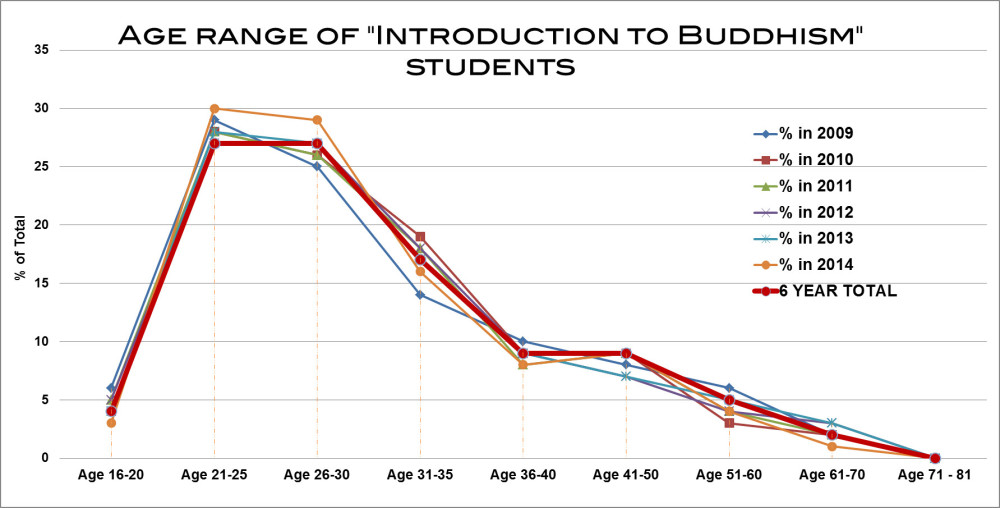
As you can see from this graph, there’s a predominance of students in their 20’s on our Introduction to Buddhism courses. However it also shows good coverage across age groups. The ring chart below left shows that 58% of students are under 30, 26% aged between 30 – 40, and 16% over 40.
The mix of age groups among Intermediate Level students is much more even however, despite representing almost exactly the same age range, as you can see in green in the chart comparing the 2 types of courses below.
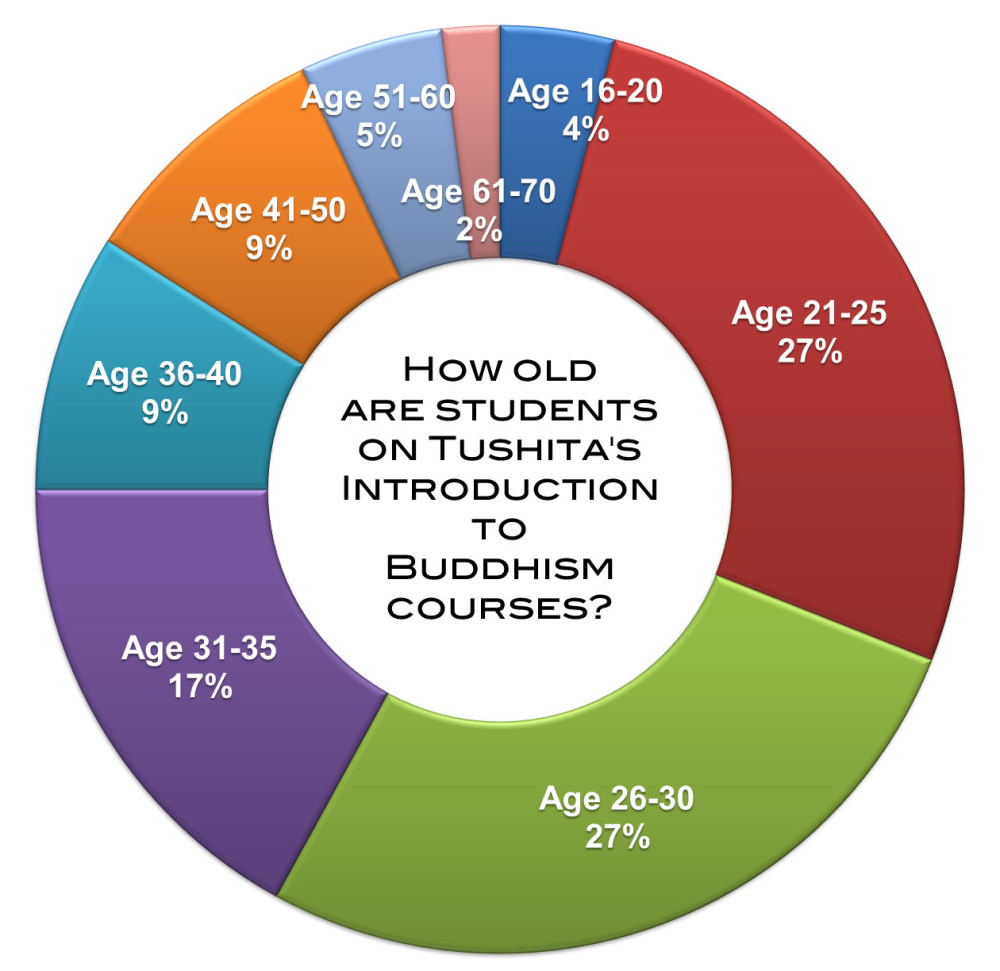
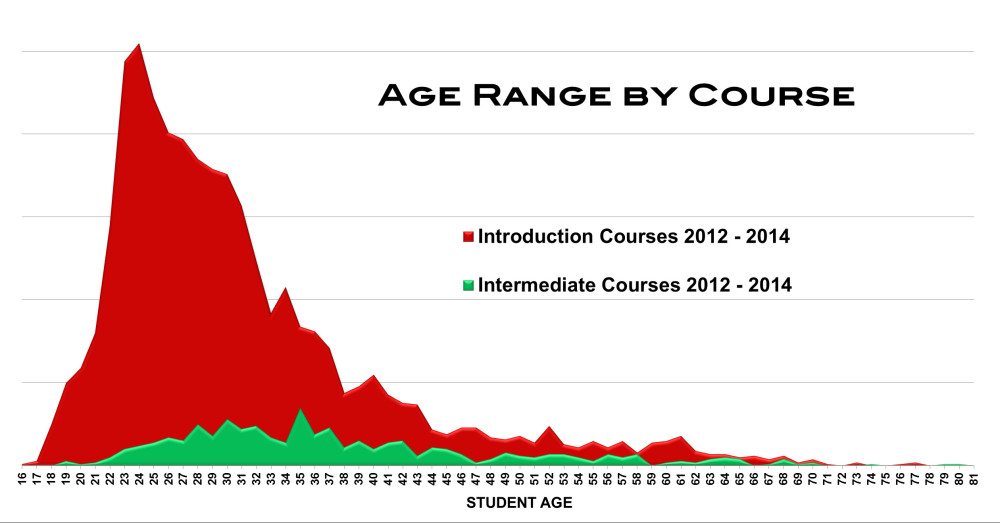
.
How many Men & Women take part in your courses?
Over the 6 years we’ve been studying our records, the gender balance of students has remained very stable, with always 5-10% more women than men taking part. This balance stays the same across all our courses.
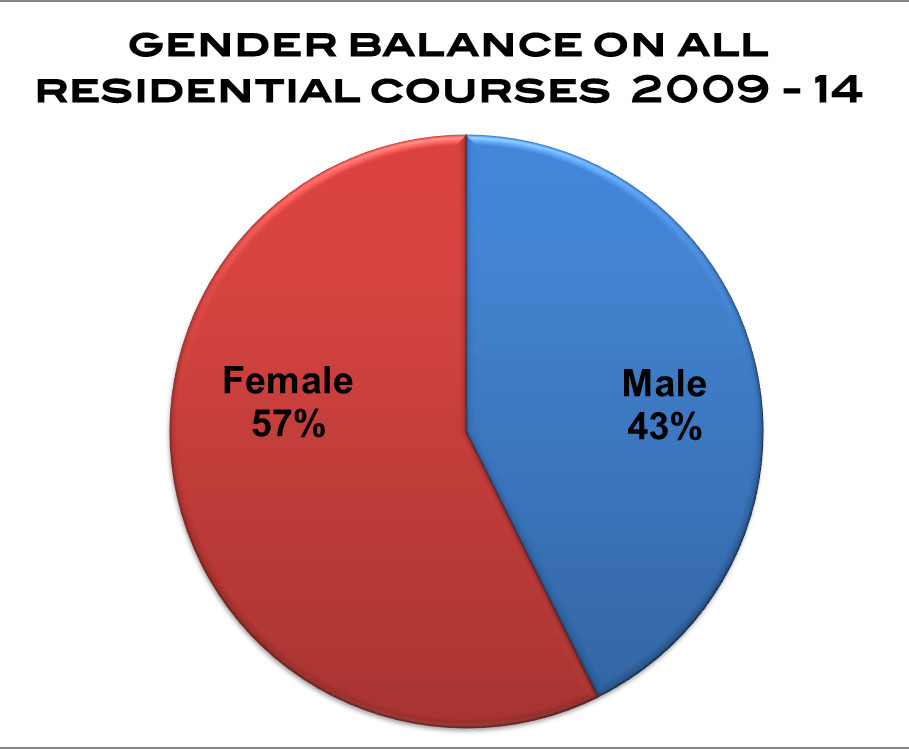
Have your students studied Buddhism or Meditation before?
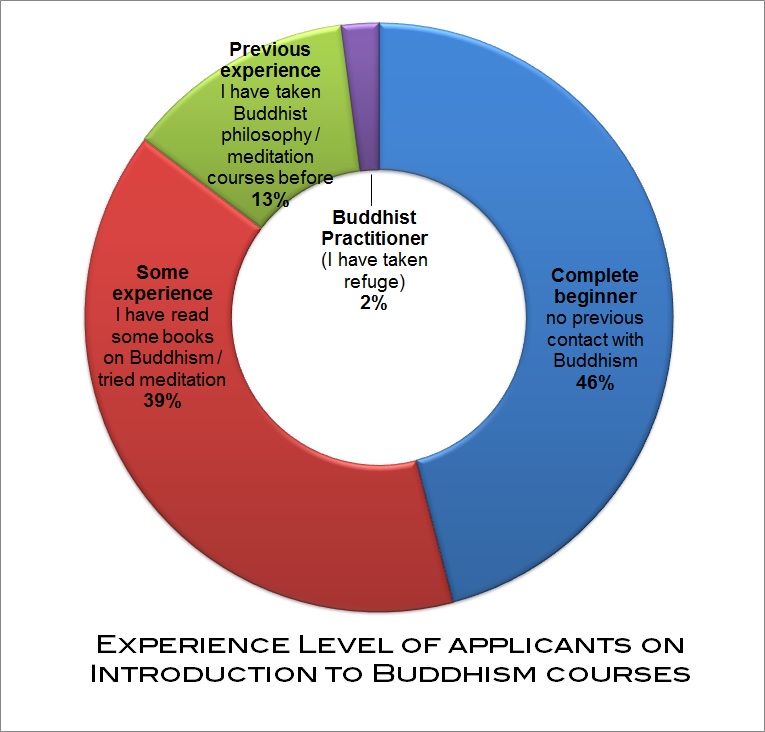 This is a question we ask people when they register for a course, so we analysed the results.
This is a question we ask people when they register for a course, so we analysed the results.
From our Introduction to Buddhism registration forms over a one-year period, we gathered the information presented in this chart.
As you can see, almost half the students on our Introduction courses are complete newcomers to Buddhist Philosophy and Meditation.
Combined with the 39% who have had some previous contact with Buddhism, through books for example, our course is the first time that 85% of our Introduction students have taken a Buddhist Philosophy or Meditation course.
This means of course that 15% of students do have significant prior experience when they take one of our Introduction courses, which shows that they can be of value to people of all experience levels!
All our other residential courses require having taken one of our Introduction to Buddhism courses before, while our group tantric retreats have an additional pre-requisite that participants must be Buddhist Practitioners (ie, have taken refuge).
Upcoming Events
- Building Inner Strength on July 27, 2024
- Guided Meditation on July 29, 2024 9:00 am
- Movie Day on July 29, 2024 2:00 pm
- Introduction to Buddhism on July 30, 2024
- Introduction to Buddhism on August 13, 2024
- Guru Puja on August 14, 2024 6:30 pm
- Introduction to Buddhism on August 31, 2024
- HH the Dalai Lama teaches locally! on September 6, 2024
- Introduction to Buddhism on September 17, 2024
- Less Desire, Less Pain – The Art of Satisfaction on October 5, 2024
About Tushita
Tushita is a centre for the study and practice of Buddhism from the Tibetan Mahayana tradition. We're located in Northern India, in the forested hills above the town of McLeod Ganj, Dharamsala - the seat in exile of His Holiness the 14th Dalai Lama.
Tushita aims to provide a friendly and conducive environment for people of all nationalities and backgrounds to learn about and put into practice the teachings of the Buddha. With this in mind we offer regular drop-in events and courses on introductory Buddhist philosophy and meditation, as well as intermediate level courses and group retreats for more experienced students.
Opening Hours
February to November
Monday - Saturday
9:30 - 11:30am
a break for lunch and then...
12:30 - 4:00pm
Closed Sundays

